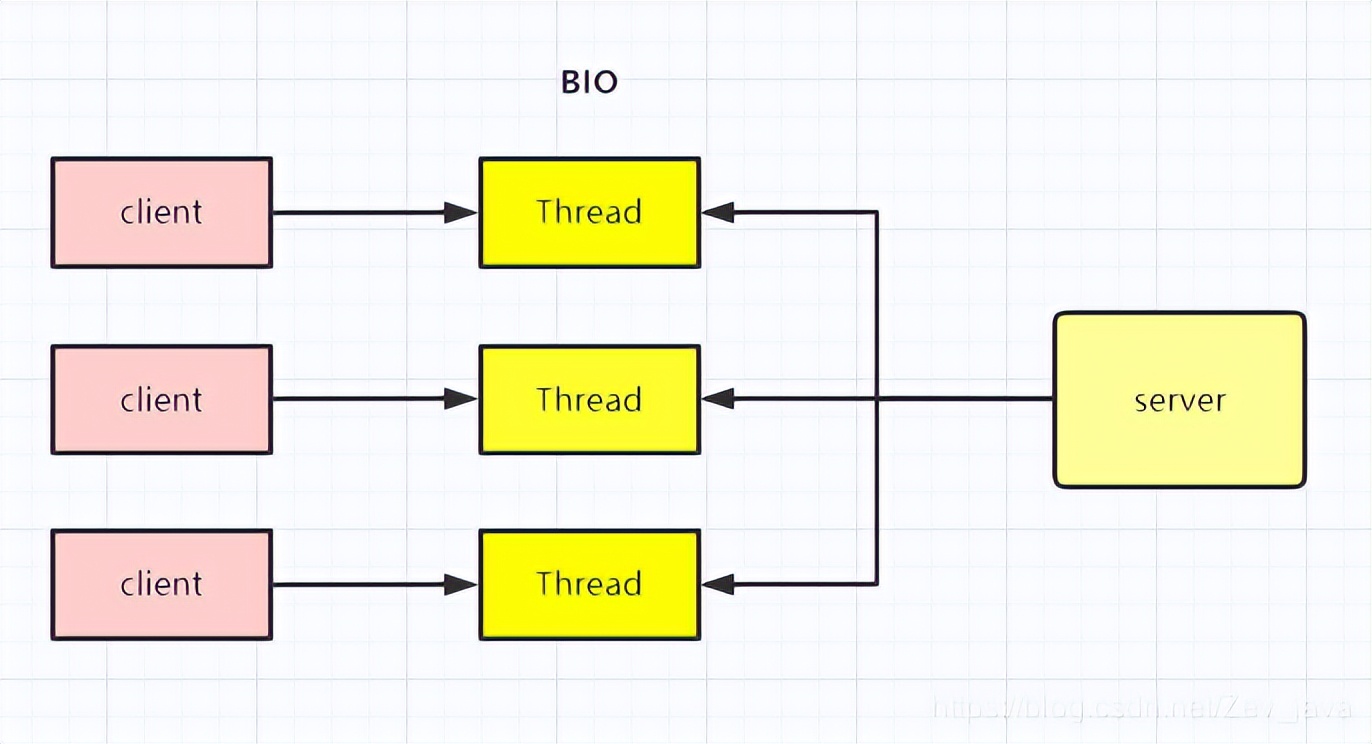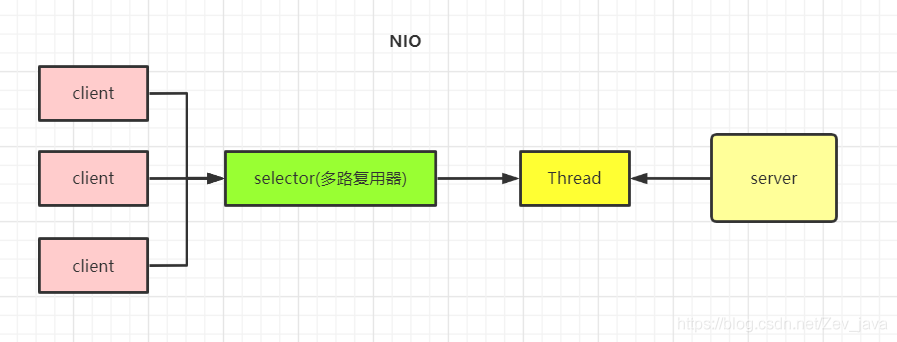同步阻塞模型,一个客户端连接对应一个处理线程。
缺点
- IO代码里read是阻塞操作,如果连接不做读写操作会导致线程阻塞,浪费资源
- 如果读写很多,会导致服务器线程过多,压力太大。
应用场景
BIO适用于连接数目较小且固定的架构,这种方式对服务器资源的要求比较高,但是程序简单易理解。

示例代码
/**
* 服务端
* @author 风信子
*/
public class SocketServer {
public static void main(String[] args) throws IOException {
ServerSocket serverSocket = new ServerSocket(9000);
while (true){
System.out.println("等待连接...");
//阻塞方法
final Socket socket = serverSocket.accept();
System.out.println("有客户端连接...");
new Thread(new Runnable() {
public void run() {
try{
handler(socket);
}catch (Exception e){
e.printStackTrace();
}
}
}).start();
}
}
public static void handler(Socket socket) throws IOException{
System.out.println("当前线程:"+Thread.currentThread().getId());
byte[] bytes = new byte[1024];
System.out.println("准备read...");
// 接受客户端数据没有就阻塞
int read = socket.getInputStream().read(bytes);
if(read!=-1){
System.out.println("接收到客户端的信息为:"+new String(bytes,0,read));
System.out.println("当前线程:"+Thread.currentThread().getId());
}
socket.getOutputStream().write("hello client".getBytes());
socket.getOutputStream().flush();
}
}
/**
* 客户端
* @author 风信子
*/
public class SocketClient {
public static void main(String[] args) throws IOException {
Socket socket = new Socket("127.0.0.1",9000);
socket.getOutputStream().write("Hello BIO".getBytes());
socket.getOutputStream().flush();
System.out.println("数据发送结束!");
byte[] bytes = new byte[1024];
// 接受服务器传回的数据
socket.getInputStream().read(bytes);
System.out.println("接收到的信息为:"+new String(bytes));
socket.close();
}
}
NIO (Non Blocking IO)
同步非阻塞模型,服务实现模型为一个线程可以处理多个连接(请求),客户端的连接都会注册到 多路复用器selector 上面,多路复用轮询到连接用IO请求就进行处理,I/O 多路复用底层一般用的是Linux API (select,poll,epoll)来实现,区别见下面表格:
| select | poll | epoll(jdk1.5及以上) | |
|---|---|---|---|
| select | poll | epoll(jdk1.5及以上) | |
| 操作方式 | 遍历 | 遍历 | 回调 |
| 底层实现 | 数组 | 链表 | 哈希表 |
| IO效率 | 每次调用进行线性遍历,时间复杂度为O(n) | 每次调用进行线性遍历,时间复杂度为O(n) | 事件通知方式,每当有io事件就绪,系统注册的回调函数就会被调用,时间复杂度为O(1) |
| 最大连接 | 有上限 | 无上限 | 无上限 |
应用场景
NIO 适用于连接数目多且连接时间短(轻量级)的架构,比如聊天服务器,弹幕系统,服务间通信。编程比较复杂。jdk1.4开始支持。

NIO 有三大组件: Channel(通道)、Buffer(缓冲区),Selector(选择器)

- channel 类似于流,每个channel对应一个buffer缓冲区,buffer底层是个数组
- channel 会注册到selector上面,由selector 根据channel读写事件的发生将其交给空闲的线程处理。
- selector 可以对应一个或多个线程
- NIO 的Buffer和Channel都是既可以读也可以写的
NIO 服务端程序分析
- 创建一个ServerSocketChannel和Selector,将serverSocketChannel注册到Selector上
- selector通过select()方法监听channel事件,当客户端连接时selector监听到连接事件,获取到ServerSocketChannel注册时绑定的selectionKey
- selectionKey通过channel()方法可以获取绑定的ServerSocketChannel
- ServerSocketChannel通过accept()方法得到SocketChannel
- 将SocketChannel注册到Selector上,关心read事件
- 注册后返回一个SelectionKey,会和该SocketChannel关联
- selector继续通过select()方法监听事件,当客户端发送数据给服务端,selector监听到read事件,获取到SocketChannel注册时绑定的selectionKey
- selectionKey通过channel()方法可以获取绑定的socketChannel
- 将socketChannel里的数据读取出来
- 用socketChannel将服务端数据写回客户端
总结:NIO模型的selector 就像一个大总管,负责监听各种IO事件,然后转交给后端线程去处理 。 NIO相对于BIO非阻塞的体现就在,BIO的后端线程需要阻塞等待客户端写数据(比如read方法),如果客户端不写数据线程就要阻塞, NIO把等待客户端操作的事情交给了大总管 selector,selector 负责轮询所有已注册的客户端,发现有事件发生了才转交给后端线程处 理,后端线程不需要做任何阻塞等待,直接处理客户端事件的数据即可,处理完马上结束,或返回线程池供其他客户端事件继续使用。还 有就是 channel 的读写是非阻塞的 。
Redis就是典型的NIO线程模型,selector收集所有连接的事件并且转交给后端线程,线程连续执行所有事件命令并将结果写回客户端*
示例代码
/**
* @author 风信子
* NIO 服务端实现
*/
public class NioServer {
public static void main(String[] args) throws IOException {
// 创建一个本地端口监听的服务socket通道,并设置为非阻塞方式
ServerSocketChannel ssc = ServerSocketChannel.open();
// selector是非阻塞模式,必须设置为非阻塞才能在selector上注册,否则会报错.
ssc.configureBlocking(false);
ssc.socket().bind(new InetSocketAddress(9000));
// 创建一个selector
Selector selector = Selector.open();
// 把ServerSocketChannel 注册到selector上面,并设置对客户端的accept感兴趣
ssc.register(selector, SelectionKey.OP_ACCEPT);
while (true){
System.out.println("等待事件发生..");
// 轮询监听channel里面的key,select 是阻塞的 accept也是阻塞的
selector.select();
System.out.println("有事件发生了..");
// 轮询监听到客户端请求
Iterator<SelectionKey> it = selector.selectedKeys().iterator();
while (it.hasNext()){
SelectionKey key = it.next();
// 删除本次处理的key ,防止下次select 重复处理
it.remove();
handler(key);
}
}
}
public static void handler(SelectionKey key) throws IOException{
if(key.isAcceptable()){
System.out.println("有客户端连接事件发生了..");
ServerSocketChannel ssc =(ServerSocketChannel) key.channel();
// NIO非阻塞体现:此处accept方法会阻塞 但它是连接事件所有很快就会执行完,不会阻塞
// 处理完连接请求不会继续等待客户端的数据发送
SocketChannel sc= ssc.accept();
sc.configureBlocking(false);
// 通过Selector 监听Channel 时对读事件感兴趣
sc.register(key.selector(), SelectionKey.OP_READ);
}else if(key.isReadable()){
System.out.println("有客户端可读数据事件发生..");
SocketChannel sc =(SocketChannel) key.channel();
ByteBuffer byteBuffer = ByteBuffer.allocate(1024);
// NIO非阻塞体现:首先read请求不会阻塞,其次这种事件响应模型,当调用到read方法是肯定是客户端发生了发送数据的事件
int len = sc.read(byteBuffer);
if(len!=-1){
System.out.println("接收到了客户端的消息:"+new String(byteBuffer.array(),0,len));
}
ByteBuffer bufferWrite = ByteBuffer.wrap("hello client".getBytes());
sc.write(bufferWrite);
key.interestOps(SelectionKey.OP_READ|SelectionKey.OP_WRITE);
sc.close();
}
}
}
/**
* @author 风信子
* NIO 客户端实现
*/
public class NioClient {
Selector selector;
public static void main(String[] args) throws IOException{
NioClient nioClient = new NioClient();
nioClient.initClient("127.0.0.1",9000);
nioClient.connection();
}
public void initClient(String ip,int port) throws IOException {
// 获取一个socket 通道
SocketChannel socketChannel = SocketChannel.open();
// 设置通道为非阻塞
socketChannel.configureBlocking(false);
// 获取一个通道管理器
this.selector = Selector.open();
// 客户端连接服务器,其实方法执行并没实现连接,需要在listen()方法中
// 调用channel.finishConnection才能完成连接
socketChannel.connect(new InetSocketAddress(ip,port));
// 将管道管理器和通道绑定,并为该通道注册SelectionKey.OP_CONNECT事件
socketChannel.register(this.selector, SelectionKey.OP_CONNECT);
}
public void connection() throws IOException{
// 轮询访问selector
while(true){
// 选择一组可以进行I/O操作的事件,放在selector中,客户端该方法不会阻塞
// 这里和服务端的方法不一样,查看api注释可以知道,服务端当至少一个通道被选中时
// selector的wakeup方法被调用,方法返回,而对于客户端来说,通道是一直被选中的
this.selector.select();
Iterator<SelectionKey> it = this.selector.selectedKeys().iterator();
while (it.hasNext()){
SelectionKey key = it.next();
it.remove();
// 连接事件发生
if(key.isConnectable()){
SocketChannel socketChannel =(SocketChannel) key.channel();
// 如果正在连接则完成连接
if(socketChannel.isConnectionPending()){
socketChannel.finishConnect();
}
// 设置成非阻塞
socketChannel.configureBlocking(false);
// 向服务器发送信息
ByteBuffer byteBuffer = ByteBuffer.wrap("hello server".getBytes());
socketChannel.write(byteBuffer);
// 连接成功之后注册读取服务器信息事件
socketChannel.register(this.selector,SelectionKey.OP_READ);
}else if(key.isReadable()){
read(key);
}
}
}
}
public void read(SelectionKey key) throws IOException{
SocketChannel channel = (SocketChannel)key.channel();
ByteBuffer byteBuffer = ByteBuffer.allocate(1024);
int len = channel.read(byteBuffer);
if(len!=-1){
System.out.println("接收到服务端信息:"+new String(byteBuffer.array(),0,len));
}
}
}
AIO(NIO 2.0)
异步非阻塞模型,由操作系统完成后回调通知服务端程序启用线程去处理,一般使用于连接数较多且连接时间长的应用。
应用场景
AIO方式适用于连接数目多且连接比较长(重操作)的架构,jdk7开始支持。
代码示例
/**
* 服务端
* @author 风信子
*/
public class AIOServer {
public static void main(String[] args) throws Exception {
final AsynchronousServerSocketChannel serverChannel =
AsynchronousServerSocketChannel.open().bind(new InetSocketAddress(9000)) ;
// 异步点: 通过钩子函数处理连接请求
serverChannel.accept(null, new CompletionHandler<AsynchronousSocketChannel, Object>() {
@Override
public void completed(AsynchronousSocketChannel socketChannel, Object attachment) {
try{
// 此处接收客户端请求,不写这行代码客户端连接不上服务器
serverChannel.accept(attachment,this);
System.out.println(socketChannel.getRemoteAddress());
ByteBuffer byteBuffer = ByteBuffer.allocate(1024);
// 异步点: 通过钩子函数处理数据接收操作
socketChannel.read(byteBuffer, byteBuffer, new CompletionHandler<Integer, ByteBuffer>() {
@Override
public void completed(Integer result, ByteBuffer attachment) {
byteBuffer.flip();
System.out.println("接收到客户端消息:"+new String(byteBuffer.array(),0,result));
socketChannel.write(ByteBuffer.wrap("hello client".getBytes()));
}
@Override
public void failed(Throwable exc, ByteBuffer attachment) {
exc.printStackTrace();
}
});
}catch (IOException e){
}
}
@Override
public void failed(Throwable exc, Object attachment) {
exc.printStackTrace();
}
});
Thread.sleep(Integer.MAX_VALUE);
}
}
/**
* 客户端
* @author 风信子
*/
public class AIOClient {
public static void main(String... args) throws Exception {
AsynchronousSocketChannel socketChannel = AsynchronousSocketChannel.open();
socketChannel.connect(new InetSocketAddress("127.0.0.1", 9000)).get();
socketChannel.write(ByteBuffer.wrap("HelloServer".getBytes()));
ByteBuffer buffer = ByteBuffer.allocate(512);
Integer len = socketChannel.read(buffer).get();
if (len != -1) {
System.out.println("客户端收到信息:" + new String(buffer.array(), 0, len));
}
}
}
BIO、NIO、AIO 对比
| BIO | NIO | AIO | |
|---|---|---|---|
| BIO | NIO | AIO | |
| IO模型 | 同步阻塞 | 同步非阻塞(多路复用) | 异步非阻塞 |
| 编程难度 | 简单 | 复杂 | 复杂 |
| 可靠性 | 低 | 高 | 高 |
| 吞吐量 | 低 | 高 | 高 |
网络段子
老张爱喝茶,废话不说,煮开水。 出场人物:老张,水壶两把(普通水壶,简称水壶;会响的水壶,简称响水壶)。
老张把水壶放到火上,立等水开。( 同步阻塞 ) 老张觉得自己有点傻 老张把水壶放到火上,去客厅看电视,时不时去厨房看看水开没有。( 同步非阻塞 ) 老张还是觉得自己有点傻,于是变高端了,买了把会响笛的那种水壶。水开之后,能大声发出嘀~~~~的噪音。 老张把响水壶放到火上,立等水开。( 异步阻塞 ) 老张觉得这样傻等意义不大 老张把响水壶放到火上,去客厅看电视,水壶响之前不再去看它了,响了再去拿壶。( 异步非阻塞 ) 老张觉得自己聪明了。
所谓同步异步,只是对于水壶而言。
普通水壶,同步;
响水壶,异步。
虽然都能干活,但响水壶可以在自己完工之后,提示老张水开了。
这是普通水壶所不能及的。
同步只能让调用者去轮询自己(情况2中),造成老张效率的低下。
所谓阻塞非阻塞,仅仅对于老张而言。
立等的老张,阻塞;看电视的老张,非阻塞。
